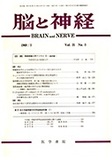Japanese
English
- 有料閲覧
- Abstract 文献概要
- 1ページ目 Look Inside
I.はじめに
2—[β—pyridyl—(2")—ethenyl]−3—(2'—methylphenyl)—quinazolinone—(4)(TV 325あるいはB169と略称される)はBoltze, Dell, Lehwald, LorenzおよびRuberg—Schweer1)(1963)によつて合成されたquinazolinone誘導体(第1図参照)であるが,本物質は電撃痙攣やMetrazol痙攣に対して強い抗痙攣作用があることがマウスを用いた実験で明らかにされた2)。また,本物質はきわめて毒性が少なく(マウスに対するLD50は6g以上),barbiturate系の抗てんかん薬に認められる催眠作用などの副作用もない点が注目されている。すなわち,B169は化学構造からも,作用機序からも,従来の諸抗痙攣剤あるいは抗てんかん薬とは異なつたものと考えられるが,われわれは,B169を生体に投与したさいの体内での運命を明らかにするために3H—標識化合物を調製し,マウスに経口投与したのち,諸組織への移行を追求するとともに尿,屎中への排泄の状況を詳細に観察した。他方,ウサギを用いて種々催痙物質に対するB169の作用をしらべるとともに,遺伝的に痙攣素因を有しているE1—マウスに対する作用も検討した。また,ネコを用いて脳波学的検索を行ない,B169の痙攣抑制機序についての若干の検索を行なつた。以下これらの諸知見について報告を行なう。
1) 3H-labeled 2-〔β-pyridyl-(2")-ethenyl〕-3-(2'-methylphenyl)-quinazolinone-(4) (B169) was pre-pared and orally administered to mice to clarify the fate of the substance in vivo.
2) B169 was easily absorbed intestinally and a peak of the concentration of B169 in blood was observed 30 minutes after the administration. B169 was almost constantly kept in the concentration of about 0.05 μg/μl in blood during one to 6 hours after the administration, and then decreased slowly.
3) Uptakes of B169 were relatively rapid and high in liver and kidney. On the other hand, it was slow and low in brain, but the significant uptake was observed upto 12 hours after the administration. Such investigations were done also on heart, lung or kidney.
4) The absorbed B169 was excreated mainly through kidney. A peak of the concentration was observed one hour or more after administration.
5) B169 was intestinally absorbed so effectivly that little was observed in feces.
6) B169 inhibited completely convulsion induced by γ-guanidinobutyric acid or taurocyamine.
7) B169 inhibited convulsion of El-mouse.
8) According to EEG analysis, B169 was inhibit-ory to the electrically induced after-discharges from the hippocampus and the motor cortex, preferentially to the latter.

Copyright © 1969, Igaku-Shoin Ltd. All rights reserved.


